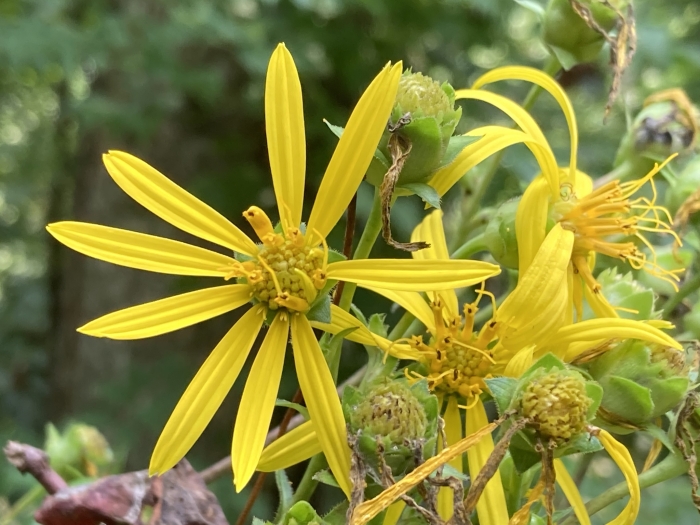Whorled Rosinweed
(Silphium asteriscus var. trifoliatum)
Whorled Rosinweed (Silphium asteriscus var. trifoliatum)
/
/

Hill Craddock
CC BY 4.0
Image By:
Hill Craddock
Recorded By:
Copyright:
CC BY 4.0
Copyright Notice:
Photo by: Hill Craddock | License Type: CC BY 4.0 | License URL: http://creativecommons.org/licenses/by/4.0/ | Rights Holder: Hill Craddock | Publisher: iNaturalist | Date Created: 2021-07-31T12:40:56-07:00 |



































Estimated Native Range
Summary
Silphium asteriscus var. trifoliatum, commonly known as Whorled Rosinweed, is a deciduous perennial herb native to prairies, glades, and open woodlands in the Central and Eastern United States. This species typically grows to a height of 3-5 feet (0.9-1.5 meters) and a width of about 1 foot (0.3 meters). It has a distinctive appearance with tall, sturdy stems and whorled leaves that are arranged in tiers. The bright yellow, daisy-like flowers bloom in the summer and early fall and are quite showy, attracting pollinators such as bees and butterflies.
Whorled Rosinweed is valued for its drought tolerance and its ability to thrive in poor soils, making it a low-maintenance choice for naturalistic plantings and wildflower gardens. It is often used in prairie restorations, as well as in borders and as a specimen plant. This plant prefers full sun to part shade and can tolerate a range of soil types, though it does best in well-drained soils. While generally pest and disease-free, it can occasionally suffer from leaf spots or rust. Whorled Rosinweed is not known for aggressive roots or invasiveness, making it a good choice for gardeners looking for a reliable and environmentally beneficial plant.CC BY-SA 4.0
Whorled Rosinweed is valued for its drought tolerance and its ability to thrive in poor soils, making it a low-maintenance choice for naturalistic plantings and wildflower gardens. It is often used in prairie restorations, as well as in borders and as a specimen plant. This plant prefers full sun to part shade and can tolerate a range of soil types, though it does best in well-drained soils. While generally pest and disease-free, it can occasionally suffer from leaf spots or rust. Whorled Rosinweed is not known for aggressive roots or invasiveness, making it a good choice for gardeners looking for a reliable and environmentally beneficial plant.CC BY-SA 4.0
Plant Description
- Plant Type: Herb
- Height: 3-5 feet
- Width: 0.6-1 feet
- Growth Rate: Moderate
- Flower Color: Yellow
- Flowering Season: Summer, Fall
- Leaf Retention: Deciduous
Growth Requirements
- Sun: Full Sun, Part Shade
- Water: Low, Medium
- Drainage: Medium
Common Uses
Bee Garden, Bird Garden, Butterfly Garden, Low Maintenance
Natural Habitat
Native to prairies, glades, and open woodlands in the Central and Eastern United States
Other Names
Common Names:
Scientific Names: , Silphium asteriscus var. trifoliatum, Silphium trifoliatum, Silphium asteriscus subsp. trifoliatum, Silphium trifoliatum var. trifoliatum, Silphium atropurpureum f. hirticaule, Silphium ternatum, Silphium atropurpureum, Silphium atropurpureum f. atropurpureum, Silphium ternatum var. atropurpureum
GBIF Accepted Name: Silphium asteriscus var. trifoliatum (L.) Clevinger